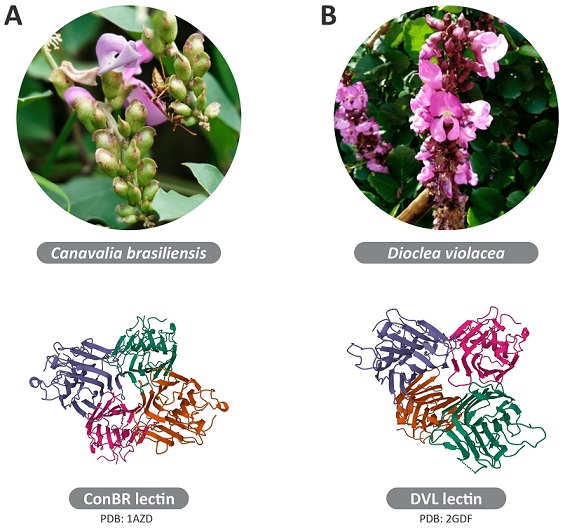COVID-19 Antivirals: Brazilian Study Reveals Mannose-Binding Lectins As Promising Antiviral Agents Against SARS-CoV-2
Nikhil Prasad Fact checked by:Thailand Medical News Team Sep 07, 2023 2 years, 3 months, 2 weeks, 3 days, 9 hours, 4 minutes ago
COVID-19 Antivirals: The COVID-19 pandemic has spurred extensive research into the development of effective antiviral treatments to combat the SARS-CoV-2 virus. Among the many avenues explored, an intriguing discovery has emerged from a collaborative effort involving several prestigious Brazilian institutions: the Federal University of Uberlândia (UFU), São Paulo State University (Unesp), Federal University of Cariri (UFCA), CEUMA University, Oswaldo Cruz Foundation (Fiocruz), and the University of Southwest of Bahia. Their groundbreaking research has unveiled the potent antiviral properties of mannose-binding lectins, specifically Canavalia brasiliensis lectin (ConBR) and Dioclea violacea lectin (DVL), against SARS-CoV-2.
 Lectins ConBR and DVL: Origin and 3D structure. (A) Canavalia brasiliensis, denominated “ConBR”, was first purified in 1979 from seeds of C. brasiliensis, also called Brazilian jackbean, and the 3D structure of the ConBR lectin (PDB ID: 1AZD). (B) Lectin purified from Dioclea violacea seeds, abundant in Brazilian vegetation, denominated “DVL”, exhibits mannose-binding specificity, and the 3D structure of DVL lectin (PDB ID: 2GDF).
The Spike Protein and SARS-CoV-2 Infection
Lectins ConBR and DVL: Origin and 3D structure. (A) Canavalia brasiliensis, denominated “ConBR”, was first purified in 1979 from seeds of C. brasiliensis, also called Brazilian jackbean, and the 3D structure of the ConBR lectin (PDB ID: 1AZD). (B) Lectin purified from Dioclea violacea seeds, abundant in Brazilian vegetation, denominated “DVL”, exhibits mannose-binding specificity, and the 3D structure of DVL lectin (PDB ID: 2GDF).
The Spike Protein and SARS-CoV-2 Infection
The entry of SARS-CoV-2 into host cells is a complex process primarily mediated by the interaction between the viral spike protein (S) and the angiotensin-converting enzyme 2 (ACE-2) cell receptor. The spike protein is heavily glycosylated, which makes it a prime target for potential antiviral interventions. This glycosylation plays a crucial role in modulating the virus's ability to fuse with host cell membranes and interact with cell receptors.
Mannose-Binding Lectins: Nature's Antiviral Proteins
Lectins are proteins with a remarkable ability to bind to specific sugar moieties found in glycoproteins, glycolipids, and free monosaccharides. These proteins have shown their mettle as potent antiviral agents by recognizing and interacting with specific glycans present on the surface of viruses, hindering their ability to infect host cells.
Two such mannose-binding lectins, ConBR and DVL, have been isolated from Brazilian flora, Canavalia brasiliensis and Dioclea violacea, respectively. These lectins have previously demonstrated potent antibacterial and antiviral effects against various infectious agents. Their specificity for mannose, a sugar molecule prevalent in SARS-CoV-2's glycosylated spike protein, led researchers to hypothesize their potential efficacy against the virus.
The Antiviral Efficacy of ConBR and DVL
The
COVID-19 Antivirals research team embarked on a comprehensive investigation into the antiviral activity of ConBR and DVL against SARS-CoV-2. They utilized a VSV-SARS-CoV-2 pseudotyped virus model to screen the lectins' in vitro activity. Subsequently, the antiviral activity was validated against the infectious SARS-CoV-2 Wuhan-Hu-1 strain and its variants, Omicron and Gamma.
The results were nothing short of remarkable. ConBR
and DVL exhibited robust antiviral activity, with selectivity indexes (SI) of 7, 1.7, and 6.5 for ConBR, and 25, 16.8, and 22.3 for DVL against the SARS-CoV-2 Wuhan-Hu-1 strain, and variants Gamma and Omicron, respectively. These SI values suggest a high degree of selectivity for inhibiting viral infection while sparing host cells.
Blocking Virus Entry: A Critical Mechanism
The mechanism underlying the lectins' antiviral activity revolves around their ability to interact with glycans on the viral spike protein. This interaction disrupts the virus's attachment to host cell receptors, specifically ACE-2. Intriguingly, the presence of mannose, a sugar found on the spike protein, nullified the antiviral activity of ConBR and DVL. This discovery underscores the significance of mannose-binding specificity in lectins' action against SARS-CoV-2.
Molecular Insights into Lectin-Spike Interactions
In-depth molecular analyses revealed the binding interactions between SARS-CoV-2 S protein and ConBR or DVL. The binding energies calculated for these interactions were substantial, with -85.4 Kcal/Mol for ConBR and -72.0 Kcal/Mol for DVL. These findings suggest that the lectins interact with the spike protein, particularly in regions rich in mannose-glycans, thereby disrupting the interaction between the spike protein and ACE-2.
Beyond Virus Entry: Inhibition of Post-Entry Replication
ConBR and DVL not only prevented viral entry into host cells but also exhibited strong inhibition of post-entry replication. This dual-action mechanism makes them particularly promising as potential antiviral agents. Furthermore, these lectins protected host cells from infection, further validating their antiviral prowess.
Implications for Future Research and Therapeutics
The antiviral properties of ConBR and DVL against SARS-CoV-2, as revealed in this study, open up exciting avenues for future research and therapeutic development. These lectins, derived from Brazilian flora, have the potential to serve as templates for the development of novel antiviral drugs against COVID-19. Their ability to inhibit virus entry, replication, and protect host cells suggests a multifaceted approach to combating SARS-CoV-2.
Future studies could explore the use of three-dimensional organoids to better understand the virus-host interactions and to assess the lectins' efficacy in a more physiologically relevant model. Additionally, considering the potential safety and tolerability of lectins, as demonstrated in previous research, in vivo assays could be the next step in validating their effectiveness as antiviral compounds.
In conclusion, the research conducted by these Brazilian institutions sheds light on the promising antiviral properties of mannose-binding lectins, particularly ConBR and DVL, against SARS-CoV-2. This discovery represents a significant step in the ongoing global effort to combat the COVID-19 pandemic and paves the way for the development of innovative antiviral treatments.
The study findings were published in the peer reviewed journal: Viruses.
https://www.mdpi.com/1999-4915/15/9/1886
For the latest
COVID-19 News, keep on logging to Thailand Medical News.
